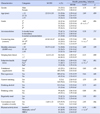1. Lee RL, Loke AJ. Health-promoting behaviors and psychosocial well-being of university students in Hong-Kong. Public Health Nursing. 2005; 22(3):209–220. DOI:
10.1111/j.0737-1209.2005.220304.x.
2. Han JK. The mediational effect of the happiness factor in the relationship between mindfulness levels and quality of life. The Korean Journal of Counseling and Psychotherapy. 2008; 20(3):735–751.
3. Chung YH, Seo NS, Moon SH. Related factors in health promotion behavior by gender among college students. The Journal of Korean Society of School Health. 2011; 12(2):29–42.
4. Baek HC, Lee SJ, Shin GS, Lim EJ. Effect of resistance band exercise on body composition, physical fitness and health promoting behavior in nursing students. Journal of Korean Public Health Nursing. 2014; 28(2):310–319. DOI:
10.5932/JKPHN.2014.28.2.310.

5. Tavolacci MP, Delay J, Grigioni S, Déchelotte P, Ladner J. Changes and specificities in health behaviors among healthcare students over an 8-year period. PLoS One. 2018; 13(3):e0194188. DOI:
10.1371/journal.pone.0194188.

6. Kim YH, Joung MS, Lee JA. Study on health promoting behavior determinant of nursing students. Journal of Korean Public Health Nursing. 2002; 16(2):285–303.
7. Pender NJ. Health Promotion in Nursing Practice. 3rd ed. Standford, Connecticut: Appleton and Lange;1996. p. 320.
8. Yoo KH. A study on health promotion lifestyles between college nursing students who live with parents and self-boarding. The Journal of Korean Academic Society of Nursing Education. 2011; 17(2):306–316. DOI:
10.5977/JKASNE.2011.17.2.306.

9. Goldberg DP. Manual of the general health questionnaire. Windsor, Berkshire: NFER-Nelson;1978. p. 32.
10. Griffin KW, Friend R, Eitel P. Effects of environmental demands, stress, and mood health practices. Journal of Behavior Medicine. 1993; 16(6):643–661. DOI:
10.1007/bf00844724.
11. Ryu EJ, Kwon YM, Lee KS. A study on psychosocial well-being and health promoting lifestyle practices of university students. Korean Journal of health education and Promotion. 2001; 18(1):49–60.
12. Pender NJ. Health promotion model. In : Alligood MR, editor. Nursing theories and their works. St. Louis, Missouri: Elsevier Mosby;2014. p. 396–416.
13. Lee JY, Song YS. The relationship between mindfulness and health promotion behavior among nursing students: The mediating effect of self-efficacy. Journal of the Korean Data Analysis Society. 2017; 19(6):3391–3402.

14. Lee CG, Lee HK, Park YS. College students' experiences of health behaviors. Journal of Qualitative Research. 2017; 18(1):49–65.
15. Son HM. Application of mixed method research. Journal of Korean Association For Qualitative Research. 2018; 3:391–339.

16. Morse JM, Niehaus L. Mixed method design: Principles and procedures.
M Kim
SE Chung
J Cha
. California. Walnut Creek: Left Coast Press;2009.
17. Tahara Y, Moji K, Aoyagi K, Tsunawake N, Muraki S, Mascie-Taylor CG. Age-related pattern of body density and body composition of Japanese men and women 18-59 years of age. American Journal of Human Biology. 2002; 14(6):743–752. DOI:
10.1002/ajhb.10091.

18. Chang SJ. Stress. The Korean Society for Preventive Medicine. Standardization of health collection and measurement of health statistics data. Seoul: Gyechuk Munwhasa;2000. p. 92–143.
19. Schwarzer R, Jerusalem M. Generalized self-efficacy scale. In : Marie J, Stephen CW, John W, editors. Measures in health psychology: A user's portfolio. Windsor, Berkshire: NFER-Nelson;1995. p. 35–37.
20. Walker SN, Sechrist KR, Pender NJ. The health promoting life style profile: Development and psychometric characteristics. Nursing Research. 1987; 36(2):76–81.
21. Yun SN, Kim JH. Health-promoting behaviors of the women workers at the manufacturing industry-based on the Pender's health promotion model. Korean Journal of Occupational Health Nursing. 1999; 8(2):130–140.
22. Elo S, Kyngäs H. The qualitative content analysis process. Journal of Advanced Nursing. 2008; 62(1):107–115.

23. Lincoln YS, Guba EG. Naturalistic inquiry. Newbury Park, CA: Sage;1985. p. 416.
24. Park HS, Ha JH, Lee HJ. Body composition and dietary selfefficacy of nursing students. Korean Society of Muscle and Joint Health. 2016; 23(2):95–104.

25. Chung HC, Chan KJ. A study on correlations between dietary nutrients and body composition of college students. Journal of Korean Society Food Science Nutrition. 2006; 35(10):1378–1384.
26. Shin GN, Kim YR, Kim MH. Nutritional evaluation of convenience meals in convenience stores near the universities. Korean Journal of Community Nutrition. 2017; 22(5):375–386. DOI:
10.5720/kjcn.2017.22.5.375.

27. Yoo KH, Cho KM. A study of factors influencing health promotion lifestyle in women college students. The Journal of Korean Academic Society of Nursing Education. 2012; 18(2):343–352. DOI:
10.5977/jkasne.2012.18.2.343.

28. Park JY, Kim NH. Relationships between physical activity, health status, and quality of life of university students. Journal of Korean Public Health Nursing. 2013; 27(1):153–165. DOI:
10.5932/JKPHN.2013.27.1.153.

29. Song YE, Kim CH. The relationship between depression levels and personal relationship following physical activity levels of female university students. Korea Society for Wellness. 2014; 9(3):135–144.
30. Park MK, Lee ES. The effect of aroma inhalation method on stress responses of nursing Students. Journal of Korean Academy of Nursing. 2004; 34(2):344–351. DOI:
10.4040/jkan.2004.34.2.344.





 PDF
PDF ePub
ePub Citation
Citation Print
Print








 XML Download
XML Download